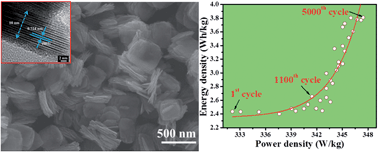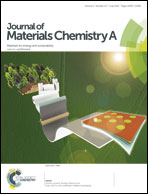Layered ternary sulfide CuSbS2 nanoplates for flexible solid-state supercapacitors†
Abstract
Layer-structured materials are advantageous for supercapacitor applications owing to their ability to host a variety of atoms or ions, large ionic conductivity and high surface area. In particular, ternary or higher-order layered materials provide a unique opportunity to develop stable supercapacitor devices with high specific capacitance values by offering additional redox sites combined with the flexibility of tuning the interlayer distance by substitution. CuSbS2 is a ternary layered sulfide material that is composed of sustainable and less-toxic elements. We report the results of a systematic study of CuSbS2 nanoplates of varying thickness (4.3 ± 1.4 to 105 ± 5.5 nm) for use as supercapacitors along with the effect of ionic size of electrolyte ions on the specific capacitance and long-term cycling performance behavior. We have obtained specific capacitance values as high as 120 F g−1 for nanoplates with thickness of 55 ± 6.5 nm using LiOH electrolyte. Electronic structure calculations based on density functional theory predict that with complete surface coverage by electrolyte ions a specific capacitance of over 1160 F g−1 is achievable using CuSbS2, making it a very attractive layer-structured material for supercapacitor applications. Additionally, the calculations indicate that lithium ions can be intercalated between the van der Waals layers without significantly distorting the CuSbS2 structure, thereby further enhancing the specific capacitance by 85 F g−1. Quasi-solid-state flexible supercapacitor devices fabricated using CuSbS2 nanoplates exhibit an aerial capacitance value of 40 mF cm−2 with excellent cyclic stability and no loss of specific capacitance at various bending angles. Moreover, the supercapacitors are operable over a wide temperature range. We have further compared the electrochemical behavior of CuSbS2 with other non-layered phases in the system, namely Cu3SbS3, Cu3SbS4 and Cu12Sb4S13 that clearly highlight the importance of the layered structure for enhancing charge storage.

- This article is part of the themed collection: 2015 Journal of Materials Chemistry A Hot Papers

 Please wait while we load your content...
Please wait while we load your content...